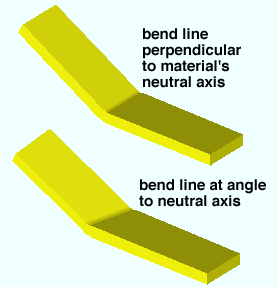 Bend on Line Command
Bend on Line Command
- Step-By-Step
- Undo
- Tips and Tricks
- Related Tools
1 . Before using this tool:
1a : Use one of the Surface tools to go to the surface on which you want to bend the material. The bending will be toward you. The view should show the length and width (but not the thickness) of the material. On a wide flange or channel section, for example, snap to web near side if you want the bending to be toward the near side.
1b : Place construction lines so that there are INCL points where you want to locate the bending line.
2 . Preselect a material to enable the Materials contextual page and click the Bend on Line icon found in the Operations section. Skip step 3.
Alternative : Invoke Bend on Line using the Find Tool by searching the command name and clicking the Bend on Line icon, which is pictured above. Proceed to step 3.
Learn more about alternative methods for launching commands.
3 . Skip this step if you already selected a material in step 2.
3a : Bend on Line prompts you to use Select One Item mouse bindings to left-click
( Select ) a material. This prompting also occurs when more than one material or a member (rather than a submaterial) is selected before invoking the command.
|
|
|
Select One Item bindings. |
4 . The status line prompts, "Locate bend base line." Locate- Pan -Return mouse bindings become active along with various Locate options.
|
|
|
bindings |
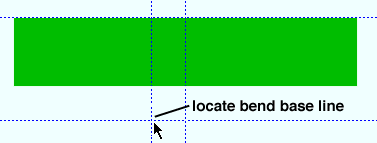
Alternative 1 : Select the Locate icon you want (if it's not selected already), then place your mouse pointer (
) so the point location target (
) snaps to a point above or below the material, then left-click ( Locate ). Go to step 5.
Alternative 2 : Right-click ( Return ) to cancel the Bend on Line operation. Do not continue.
5 . The status line prompts, "Locate bend base line."
|
|
|
bindings |
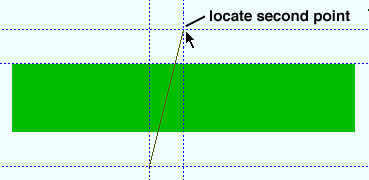
Alternative 1 : Position the point location target (
) on a point that is on the opposite side of the material as the first point, then left-click ( Locate ).
Alternative 2 : Right-click ( Return ) to cancel the Bend on Line operation. Do not continue.
6 . The Angle dialog opens. On it are entry fields for an " Angle of bend " and " Bend radius ."
Angle of bend: A positive or negative (-) number of degrees. The magnitude of the angle defines the angle of the bend. The sign (+ or - ) defines which end of the material bends toward you in the current view.
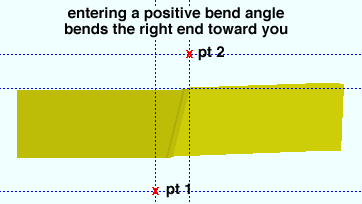
A positive angle bends the material counterclockwise around point 1 to point 2 of the line established in steps 4 and 5 .
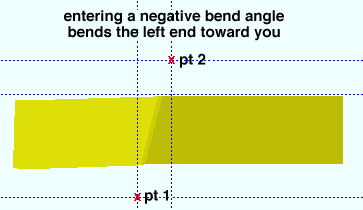
A negative (-) angle bends the material in a clockwise direction (looking from point 1 to 2). Bend radius: A positive distance (in the primary dimension " Units " or other units ) that defines the sharpness of the bend. A smaller distance gets you a sharper bend. Larger distances result in a more gradual bend.
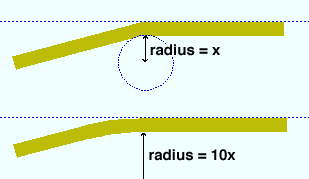

Alternative 1 : Press the " OK " button to apply the " Angle of bend " and " Bend radius " to the material being bent. Go to step 7.
Alternative 2 : Press the " Cancel " button to end the Bend on Line operation and keep everything as it was before step 2. Do not continue.
7 . Yes - No mouse bindings become active, and the status line prompts, "Verify material bend." Your computer screen redraws to show the bend.
|
|
|
bindings |
Alternative 1 : Left-click ( Yes ) to continue on to step 8.
Alternative 2 : Right-click ( No ) to cancel the Bend on Line operation and keep everything as it was before step 2. Do not continue.
8 . The Change All Options window opens. On it is a " Warnings " list. Material change " Options " become active along with the Warnings if the 3D model contains other pieces of material with the same submaterial piecemark as the material you performed this operation on.

Alternative 1 : Make the appropriate selections on this window, then press the " OK " at the bottom of the window to regenerate the material.
Alternative 2 : Press the " Cancel " button to end the Bend on Line operation and keep everything as it was before step 2. Do not continue.
1 .Double-click the bent material to open that material's edit window.
1a : Press the " OK " button at the bottom of the material edit window.
2 . A yes-no dialog box appears with the question, "Do you want to regenerate this material to clear user modified material operations?
2a : Press the " Yes " button to regenerate the material and clear the bend operation. Go to step 3.
3 . The Change All Options window opens. A Warning states "Material will be regenerated."


3a : Make the appropriate selections on this window and press the " OK " button on the bottom of the window. The material is regenerated with the bend operation removed.
- Depth checking (affects Bend on Line )
- Bend on Radius Point
- Bent Plate Add (for single bend on plate)
- Bent Plate Layout (for multiple bends on plate)
- MemberMaterial.Material.SubMaterial.IsMaterialBent
